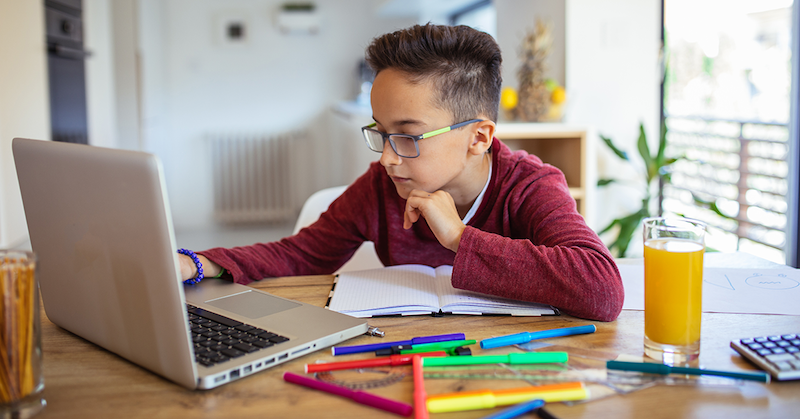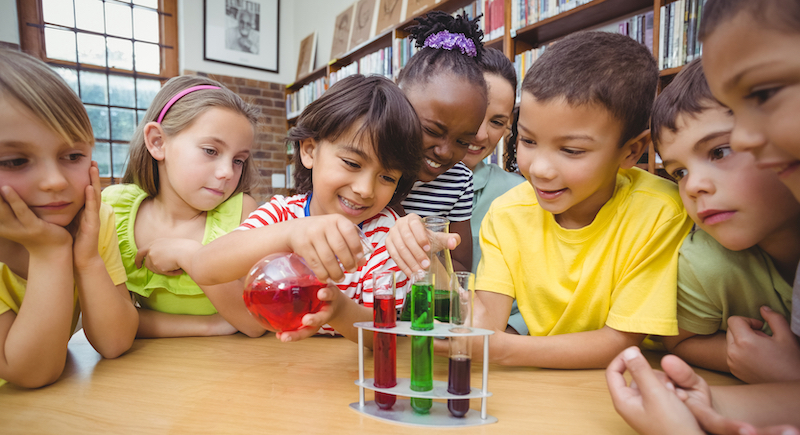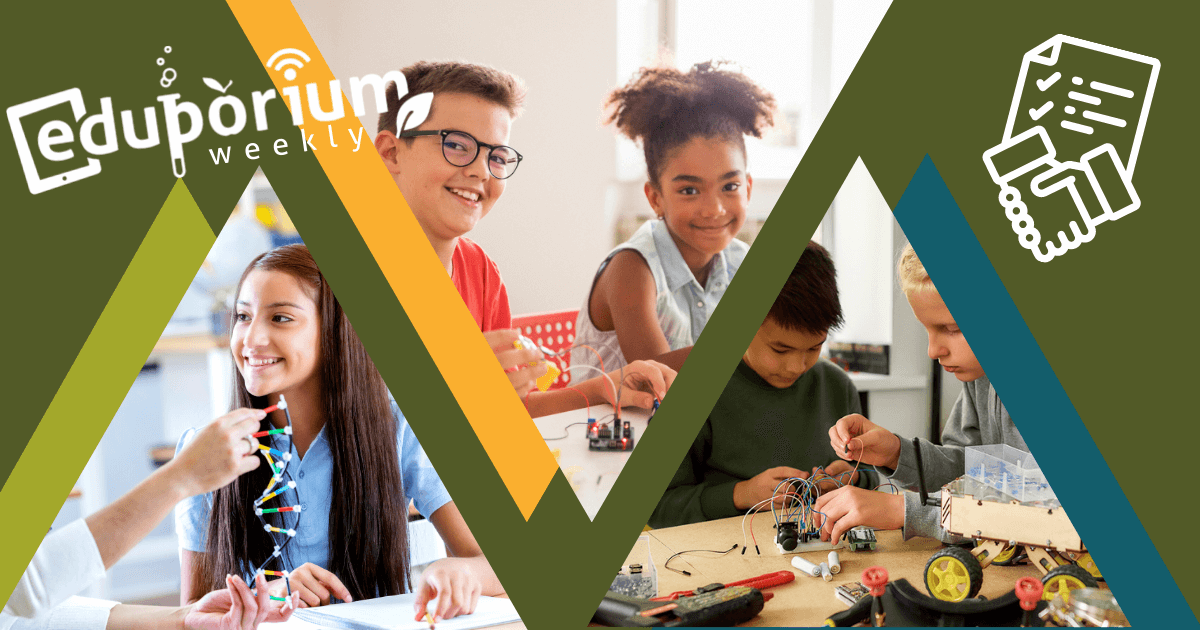We’re always talking about active and project-based learning—both of which help students develop real-world skills through hands-on experiences. When learning moves from a textbook to the physical world, students tend to become more engaged, excited about collaborating, and willing to devote more time to creative problem solving. Project-based learning is one example of this. Since it's so group-oriented, these experiences help students develop more than academic skills. They truly help them learn to build connections with their peers, their communities, their teachers, and their work. And, this also helps students take greater pride in what they’re doing as they realize they can make a difference.
Creating Real-World Connections
This should come as no surprise to most educators but the No. 1 connection that project-based learning can help create is a connection between students and the real world. So often, students aren't prepared to take the next step—whether that’s enrolling in college or entering the workforce—because their experiences in grade school weren't aligned with real world development. The great thing about PBL, however, is that teachers in all grades can facilitate experiences that mirror the real world. Since projects can take so many different directions and encompass a lot of different topics, the options for educators are plentiful and students who take part in PBL often reap the benefits down the road.
Cross-curricular PBL connections.
Of course, allowing students to create projects or simply assigning one just to change things up isn't the best approach. One reason that PBL is so popular is because it works but that’s only if educators and school leaders strategically tie in curricular connections and skills development while students collaborate. This is how they will ultimately use PBL to master content, progress, and use those skills to discover and implement solutions that are viable in the real world. Plus, in order for PBL to be effective, teachers need some way to measure the success students achieve. By establishing real-world connections and applying what they know, students can more clearly demonstrate what they’ve learned.
Project-based learning in the classroom.
In an ideal project-based learning situation, teachers create authentic projects for students to complete in the real world while receiving feedback from either town officials, citizens, or both. When students take on a real-world issue as part of PBL, the learning they experience is a lot more tangible. And, if they’re looking to solve something in their community, then their connections to those problems become a lot more real. With the experiences students gain through PBL, they can increase their motivation, enthusiasm, academic performance, and skills development. The subject matter is also tied to the student’s own world, making it much more relevant and real to them.
Empowering Students to Create Connections
Sometimes, fostering relationships is more important that simply possessing relevant skills and knowledge. Hopefully, students never experience being passed over for an opportunity solely because the decision maker knows someone else personally but this is possible. That's why helping them develop strong interpersonal skills is increasingly important since they'll likely spend a whole lot of time working with others in the real world. One way to help them build these skills is by introducing them to collaborative project-based learning early on. Since PBL embodies so much active learning, students need to constantly communicate and this can ultimately help prepare them for a world of much of the same.
Collaborative learning opportunities for students.
Focusing on collaboration allows teachers to help students recognize the value of relationship building while establishing a positive classroom culture. It also helps kids learn more about each other, including how to work together towards reaching a common goal. A lot of the time, traditional classroom instruction might have holes when it comes to helping students connect with one another—something that project-based learning experiences can help fill while allowing teachers to still ensure that they’re teaching all of the most important concepts. Technology can also drive student collaboration and, more importantly, help them learn about the resulting benefits.
Collaboration, connections, and classroom experiences.
Many teachers appreciate how student interactions no longer have to be confined to the same classroom or school. As such, many students and teachers truly enjoy and benefit from collaboration that spans to other parts of the world. In these examples, students don’t even necessarily have to work exclusively with their classmates. For example, some educators work with combined classes regularly and this can help students learn the value of building connections with peers of different ages—something that's very beneficial for younger students, who can start learning valuable skills from older students. Also, when students lead their projects, they naturally connect with others and, ideally, build on these experiences throughout their lives.

Current Events Connections and PBL
Another way to help students make connections through project-based learning is tying the projects with current events. Current events discussions have long been part of many classrooms because it’s important for students to know about the most pressing local, national, and international news. And, since events always happen, there's always something for teachers and students to talk about in terms of current news. But, another important factor in our world is STEM and all of its extensive applications. Educators can use project-based learning and STEM education to help students make connections to current events and even empower them to create inspiring projects with one another—something that’s enjoyable, informative, and beneficial.
Technology and PBL in the news.
Of course, today’s students live in the digital age with constant access to technology and a desire to use it. So, rather than simply knowing how to find relevant information, they must also be adept at knowing how to apply it since they can typically find it within seconds. Speaking of the power of technology, there's always some new invention or innovation in the tech world. This gives students ample opportunity to research the latest tech advances and keep up with the latest news. Taking that a step further, teachers could then lead discussions about a wide variety of topics, most notably how this particular news might affect current events on a state, national, or international level.
How current events connections can drive change.
Since, unfortunately, we're facing a lot of issues at the moment, there are opportunities to tie projects to current events. One of those major problems is certainly environmental concerns. It’s a constant discussion topic and something that educators can certainly address. So, this creates an opportunity for students to bring the topic of pollution and pollution solutions into their projects. They can come up with different projects that involve testing different possible solutions to pollution, for example. And, this can get them thinking about how to apply new science or new types of technology to solving a problem like pollution—or something else they're passionate about. Plus, tying current events to project-based learning helps students evaluate events that may impact them now or in the future.
Creating Global Connections Through PBL
More often than not, project-based learning is collaborative. You might be thinking ‘Well, yeah, that’s why it presents so many opportunities for students to make connections.’ And, you would be accurate to think that way. Since it's so collaborative, there are ample opportunities to work together—even with peers who might be somewhere else. The global workforce is global for a reason—because people from different parts of the world routinely work together to learn and accomplish their greater goals. So, what’s stopping students from having the same kinds of experiences? Today, there’s no reason for them not to be. Thanks to technology, students throughout the world can collaborate on a global level and benefit from these unique learning experiences.
PBL, global connections, and fostering empathy.
In this day and age, it doesn’t take a whole lot for students to connect globally. They just need some (now) basic technology tools in order to collaborate and create some truly global connections. Depending on your school’s budget and tech capacity, there different options for hardware, like webcams. In using these communication tools to connect with students from different parts of the world, students can also engage more deeply with their PBL. They can also build on their social-emotional skills, like empathy, by working with different students and understanding some of the issues they're facing in their hometowns. This could even serve as the basis for their projects, allowing students with fresh points of view to present possible solutions to their peers while working together to come up with a creative solution.
Some top benefits of global PBL.
By weaving in some global connections, teachers can take their project-based learning lessons to the next level. This helps kids boost their communication and digital literacy skills while using social technology to interact with others. Plus, since PBL often involves complex issues, this presents opportunities to promote global readiness, creative problem solving, and taking action. Nowadays, global connections are relevant in almost any classroom, for students in any grade, and within any academic subject. Global PBL can also have a lot of similarities to traditional classroom PBL, including helping students expand their research to a global level, create together by leaning on varying ideas, and sharing progress with a wider audience.

PBL and STEM Connections
One of the greatest benefits that project-based learning provides to students is the hands-on experience. Since hands-on experiences are closely related to STEM education, it makes sense that PBL and STEM are so closely connected. As such, the engagement students get from PBL is often magnified when they’re working in a STEM-specific class. Especially once students reach middle and high school, adding more project-based experiences and collaboration to STEM projects can also help ease fears that students may have towards them. Also, for kids who think that STEM subjects will be too difficult, collaborating with other students is an important benefit. So, having the opportunity to gain insight from others allows students to feel more comfortable with what they're doing.
PBL connections to student progression.
Connecting PBL and STEM with everyday learning early on helps students get used to working like this. It also helps them see how STEM is already part of their everyday lives or potential future plans. Once STEM becomes more and more important for students, which happens as they move through grades, teachers can use a PBL approach to boost their confidence and guide learning outcomes. At the top of the list of benefits when PBL and STEM are connected is that students can see the real-life connections between the work they’re doing and work that must be done in the world. They can also demonstrate knowledge in lower stakes scenarios (not tests) and working on projects helps students discuss connections.
Strategies for connecting key curricular areas.
So, how can educators create meaningful connections between project-based learning and STEM? To create these experiences for students, it’s good for teachers to be interdisciplinary. This allows students to draw on their own experiences from multiple areas and apply them to their class work. Another tip is being authentic, which helps students see that they have room to evolve and make projects their own. You don’t want students to reach a preconceived conclusion but, rather, work together to make discoveries. Finally, teachers need to remember to remain optimistic about all the different types of connections they can create through PBL. Trusting that students will do well and providing them with challenges that they can excel at will help them enjoy project-based learning as they prepare for the future.
For the latest EdTech, STEM, and 21st century education news, follow us on Twitter and Instagram. Like us on Facebook, too, or sign up for our newsletter for our latest product announcements and offerings. If you have an idea for an Eduporium Weekly theme, send us a message on social media or comment below.



